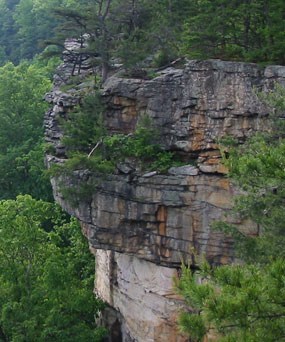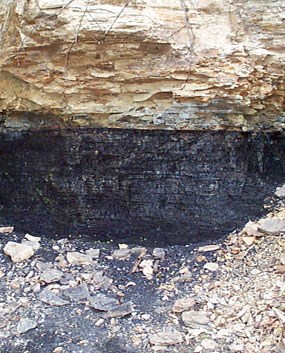
NPS photo/Louise McLaughlin 
NPS photo When you stand at an overlook in the New River Gorge, you notice the steep canyon walls and sandstone cliffs that characterize the area. The V-shaped canyon of the New River is an outstanding natural feature of West Virginia. It was caused by erosion that has occurred over a very long period of time, forming the cliffs and canyon walls. You can see the ongoing effects of erosion in the large rocks and slides that have tumbled from the cliffs and down into the river. The gorge cuts through the Appalachian Plateau, and exposes 3200 feet of very old rocks. Most of the rocks that you can see exposed in the gorge are sandstone and shale. In the lower gorge, the New River cuts through the hard Nuttall sandstone, a unique sandstone type that is 98% quartz. The area of the lower gorge around Batoff Mountain is one of the best exposures of sandstone in the area; these rocks are among the oldest found in the gorge. 
NPS photo The New River was the main headwaters of an ancient watercourse called the Teays River, which flowed west to an immense inland sea that covered the central part of North America millions of years ago. Because the New River existed before the Appalachian Mountains, it was able to cut into them as fast as they were uplifted and this very old river maintained its ancient course. The New River is the only river that cuts through the ridge and valley province of the Appalachian Mountains instead of draining from or around them. That’s what made the river valuable as a way to connect the eastern United States to the central states, and why the CSX Railroad mainline runs through the gorge today. As it formed the gorge, the river sliced into and through thick coal-bearing rocks, exposing them. This made the coal relatively easy to remove and led to the industrialization of the New River Gorge. Some of the coal found in the New River Gorge is considered globally significant because of its exceptional quality and purity. -excerpted from A Natural Resource Assessment for New River Gorge National River, by Carolyn Mahan. |
Last updated: January 22, 2020
